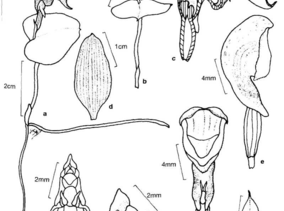You are here
Acianthinae_species
Corybas cerasinus D.L.Jones & B.Gray
Media
SUMMARY
Plant: terrestrial tuberous herb growing in colonies
Leaf: cordate to orbicular, 12-25 mm long, 10-14 mm wide, bluish green adaxially, reddish or purplish abaxially, apex apiculate
Peduncle: c. 1 mm long
Bract: closely sheathing, narrowly ovate, 3-4 mm long, 2-2.5 mm wide, acuminate
Ovary: erect, straight or incurved, 4-5 mm long, c- 2 mm wide
Flower: solitary, erect with a porrect dorsal sepal, 9-13 mm long, 5-7 mm wide, dark maroon
Dorsal sepal: concave, curved throughout, ovate-oblong when flattened, 15-23 mm long, 6-10 mm wide, dark maroon with 6-8 longitudinal striae, narrowed at base, apex apiculate, often upcurved
Lateral sepals: linear- tapered, 1.5-1.8 mm long, c. 0.3 mm wide, acuminate, porrect or projected upwards against the base of the labellum.
Lateral petals: linear-tapered, c. 1 mm long, c. 0.3 mm wide, acute, falcate, obtuse, hidden behind the labellum spurs
Labellum: much shorter than, and mostly hidden by, the dorsal sepal, maroon and white; labellum tube c. 3 mm long, erect then recurved sharply and expanded into a lamina; lamina obovate to cordate when viewed from the front, 5-7 mm long, 5-7 mm wide, white with conspicuous striae, with a prominent, deep anterior pocket, the outer margins folded back, the inner surface papillate, the outer surface and margins denticulate and hispid; callus thickened, strongly folded medially
Spurs: ca 5-7.5 mm long, ca 2 mm wide, curved forwards from ovary, white
Column: ca 4 mm long, 2 mm wide, more or less erect, white, broadened towards base; Column wings ca 0.5 mm long; anther ca 2 mm long, 1 mm wide, with a very short, blunt rostrum; stigma ca 1 mm across, 1 mm high, rectangular, sunken; pollinarium ca 1.2 mm long, 1 mm wide; pollinia yellow, mealy
Capsule: 14-16 mm long, 5-7 mm wide, ovoid, on elongated peduncle 15-20 cm long.
Type: Queensland: Cook District; Mt Walker, 2 June 1994, L.J. Roberts (D.L Jones 13022) (holo CANB; iso BRI)
Distribution: Endemic to eastern Queensland between Cooktown and the Herbert River, including Dunk Island.
Ecology: Grows in a range of habitats, particularly on exposed ridges in moist to wet sclerophyll forest (Gray & Jones 1985), with an upper canopy dominated by Allocasuarina littoralis and Banksia dentata and a ground cover of Xanthorrhoea sp. Also found growing on moist sheltered slopes in open forest dominated by Eucalyptus spp. and Allocasuarina littoralis, with a relatively sparse shrubby understorey. Soils are sands, sandy loams and gravelly loams. Corybas cerasinus may sometimes grow in extensive colonies but always has a very low proportion of flowering plants. Additionally its flowers are apparently rarely pollinated (L Roberts, pers. comm.).
Elevation: c. 10-100 m.


